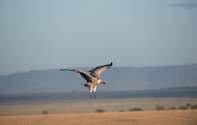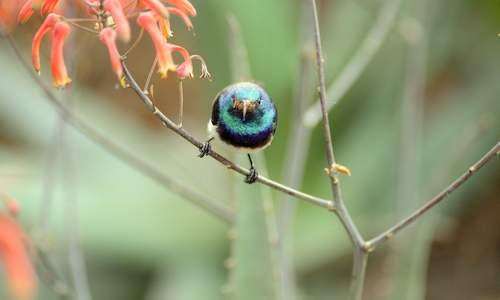
Animals, especially some birds and insects, also use the 'heavenly lights' to help them navigate during migration or movement over long distances but are increasingly frustrated by the artificial lights of 'development'. With so much nocturnal interest it is a pity that so few people take time to look at the skies during daylight.
There are numerous 'dark specks' up there that are most interesting. Hyenas and certain other animals, spend much time looking up at the sky 'reading' the message that it sends them. We can learn to do the same by watching the clouds and the wings far above us.
Tawny Eagles and Confined Elephants
As the heat of the day stirs rising air currents, elephants seek shade under the remaining large trees. Above them, on increasing scarce, suitable perches where they have spent the cool hours of the night, large birds of prey 'ruffle' their feathers and scan the air.At the sign of a grass stem, a leaf or some other bird indicating a thermal they head for the spot. They ascend in spirals to stay within the thermal until they reach 'operating altitude', from where they can begin their search for food. Wing flapping consumes a lot of energy and most large raptors attempt to 'glide' as much as possible, with the assistance of updraughts.Certain species, such as the 'snake eagles', habitually 'still hunt' from the top of suitable perches, where these still exist. They will move to different perches during the day to increase success. Where there are insufficient tree perches they will resort to 'aerial perching' while facing into the wind.
'Aerial perching' is achieved by adjusting their still, but open, wings to the wind speed, while the 'hovering' of other species is accompanied by wing flapping. Each species is adapted to hunting at its own optimal altitude among the community of large raptors - some of them at thousands of metres above ground level, beyond human vision.The upper ones are not necessarily watching the ground but are watching those birds below them - which are watching the ones below them - down to the ones nearest the ground. Like a boy's boarding school, when one runs at meal time it is a sign for all to run. Discounting the 'still hunters', tawny eagles and 'bateleurs' tend to be the lowest flying species and are often the first to locate a 'kill'.
Although the tawny eagle is called Aquila rapax it is a frequent scavenger that was named because of relatively large prey that it was presumed to have killed. Both species will often kill animals up to the size of guineafowl and hares.Being first at a carcass, these species will pick at the eyes, tongue and other available parts until ousted by competition. This ability to arrive first enables them to pick up the baits where carcasses have been poisoned and this has led to their elimination in most agricultural areas. They now only survive in the diminishing wild areas.
When a bird, at a lower altitude, discovers food its flight pattern will change and it will descend straight towards the food source, with some adjustment for wind before landing. This change in flight pattern will be noticed by the ones above, which will in turn will start descending, causing the same reaction above them.Suddenly, birds will 'appear from nowhere' - like water drawn to a plughole. The hyenas watch the vultures and will immediately react to descending flight patterns to help them locate food at a distance. When closer they will circle the area to pick up the scent before making an approach. Once a food source is depleted the search for thermals will recommence. If you notice a spiral of vultures or other species such as storks, they are going up (ascending) from feeding or bathing.Descent is indicated by them coming down in straight flight, with a frequent adjustment for wind near ground level. When birds are sitting around in trees it will indicate that, either there are still large predators on a kill, or that the birds are heavy with food and air temperatures are too low for successful 'take off'.
Full 'crops' are a sign of successful feeding but they are 'animals of habit' and those that 'missed out' will often sit around with the others until flying conditions are right. With a full complement of vulture species, a classic feeding sequence would be the lappet-faced coming in first with its powerful bill (and feathered neck) to break open the skin and feed on the surface.Then the griffons (Cape and white-backed - with long, bare necks) to feed deeper through the openings in the skin - and finally the hooded vulture, with long, thin beak (and feathered head), to feed on the scraps between the bones. This would be followed by the bone-crushing mammal scavengers.
It doesn't always work like that! Tawny eagles used to be a common sight in our game reserves but with fewer large trees they are denied perches and nesting sites. Like vultures, they normally nest on top of suitable large-tree canopy.The large birds need a substantial branch on which to perch and cannot land on a leafy canopy - hence the requirement for standing, dead trees. With an increasing elephant population and increasing collecting of firewood there are less large trees, less tawny eagles and a less efficient system for scavengers. The vultures are unable to obtain enough food and their population is diminishing - and even the hyenas and other ground scavengers suffer.This is but one example of the inter-relationships that exist between all species in a natural community. We can not destroy any one species without affecting the survival of many other, inter-related species - Nor can we keep an over population of highly adaptable elephants, in a confined space without eliminating a large diversity of less adaptable species. Liberals are isolated from the matter or can afford to escape from it, while Realists are vitally involved and have to deal with it.
Dear Dave,
I receive the Kruger Park Times at my home in Stellenbosch and read your informative articles with great enthusiasm. Can you possibly help me with some questions for which I have sought credible answers for some while.
Cedric Dallas from Stellenbosch to Dave Rushworth
Q: Why do canines and felines lap while other mammals suck when they drink ?
A. 'Short Answer' is that the carnivores can't easily 'seal' their lips for efficient sucking. My longer answer is - that all carnivorous mammals tend to have wide opening mouths. They use their 'canines' for threat, attack and defence, and also to kill prey, in many circumstances.
For this reason they need to open their mouths relatively wide. For this they need a wide gape and lips extending back into the cheek area. Because of these cut back lips they are not as easily able to suck from a surface as the back of the lips do not easily seal. They have 'flatter' tongues than herbivores, more easily suited to 'cupping' and holding liquid.
Hence they are more able to 'lap' and less able to 'suck'. If they do suck, this action has to be accompanied by a 'curled' or 'folded' tongue, which seals round a teat or other object to prevent air entering the 'gape' area of the mouth.
Dugongs, which are occasionally seen off our north eastern coast, are distantly related mammals which have much smaller mouths but also graze on aquatic vegetation. All the whales have very large mouths, for varying functions, and there may be some evolutionary association involved.
By Dave Rushworth

 Learn more about African birds. An information guide on birds in Kruger National Park. This Birds of Africa guide offers bird watching enthu...
Learn more about African birds. An information guide on birds in Kruger National Park. This Birds of Africa guide offers bird watching enthu...